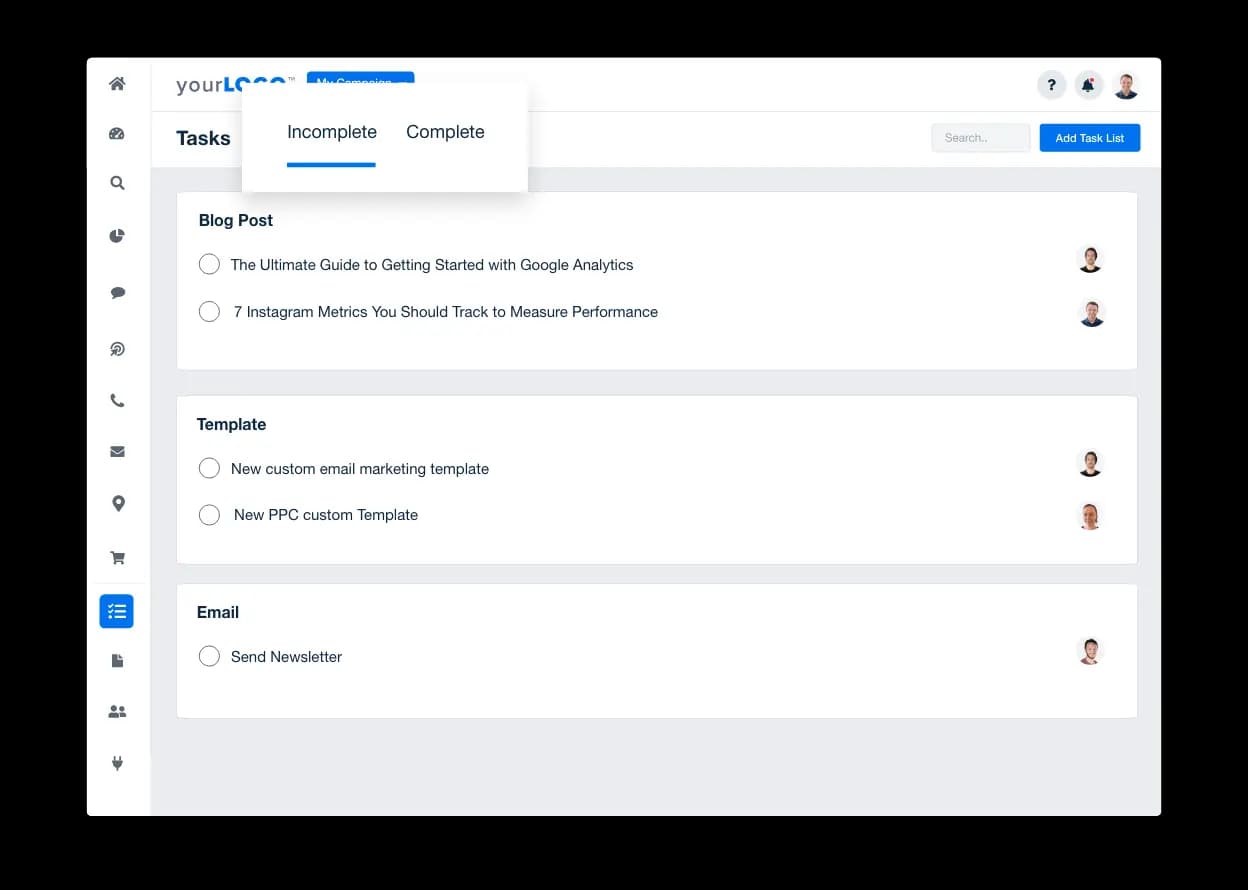Table of Contents
Table of Contents
- What Is Change Management?
- Why Does My Agency Need A Change Management Process?
- Top 5 Reasons Why Change Fails in Agencies
- 5 Principles of Change Management to Apply to Your Agency
- 3 Popular Change Management Models
- How Can You Tell If Your Agency's Change Management Process Is Working?
- "Change before you have to." -Jack Welch
7,000+ agencies have ditched manual reports. You can too.
Free 14-Day TrialQUICK SUMMARY:
A formal change management process helps agencies navigate and implement changes by preparing and supporting employees throughout the transition. It minimizes resistance and maximizes buy-in, which is essential for the successful adoption of new practices. This article details popular change management strategies, providing a framework to inspire effective change.
Human beings are naturally hardwired to resist change in favor of remaining in their comfort zone. But the only way agencies become disruptors is by constantly innovating and embracing change. So how do agencies balance this dichotomy to stay nimble and adapt? Enter: change management.
Take, for example, the meteoric rise of ChatGPT. How have your agency's employees and clients responded? Likely you’ve seen a mix of opinions, with some people diving headfirst into mastering prompts and inventing strategies while others have hung back hesitantly.
Those willing to work with new tools like ChatGPT will gain a competitive advantage, while those who resist the change may struggle to remain relevant in a new marketing landscape.
Change management processes ease resistance within your agency by presenting a framework to support team members in adopting new practices and overcoming growth plateaus. This article explores some of the most popular and successful change management strategies to inspire your agency's own change management process:
What Is Change Management?
Change management refers to the process of supporting the people within an organization through times of change. By preparing and supporting employees before, during, and after the change occurs, your agency has a better chance of successful adoption of new practices and strategies and is better equipped to ride out an unexpected storm.
The overarching goal of a change management process is to minimize resistance and maximize employee buy-in to achieve long-lasting, successful change in your agency.
Sometimes, the changes are small or gradual, such as tweaking your marketing strategies to maintain competitive advantage, switching to a better project management platform, or optimizing a workflow.
Other times, the changes can be large and sweeping, such as restructuring the organizational hierarchy, creating a new business unit, or even introducing a new corporate culture.
Why Does My Agency Need A Change Management Process?
Think about it from the team’s perspective: Leadership announces a big change within the agency. This stirs up questions like:
“How will this affect my job?”
“What will my future look like at the agency?”
“Where do I fit into this new plan?”
If employees are left alone to answer these questions and find their own solutions, they’re more likely to resist the new initiatives you’ve introduced. Not only are they dealing with the stress that comes with a change in routine, but they may worry that their job security has become shaky as well.
Effective change management processes act as a framework to prepare and support employees as change is introduced and while it’s being adopted. Employees who feel supported will be more likely to support new initiatives. It’s a win/win for everyone.
Conversely, a lack of change management processes can lead to the unsuccessful adoption of new initiatives and even compromise employee loyalty. Let’s take a closer look at the most common reasons why change fails at the agency level.
Top 5 Reasons Why Change Fails in Agencies
Studies have found that 70% of change management initiatives fail. That’s a staggering number! If we look closer, we can identify the trends that most commonly cause a change to fizzle out.
1. Lack of Support from Leadership
The traditional model of change management was top-down, where the boss told employees what needed to be changed and then closed their office door. Think of it as the authoritative “Because-I-said-so” approach.
Lack of involvement and support from agency leadership often backfires, leaving employees feeling ignored, confused, and like they lack control. All of these feelings have a negative impact on morale, creating an “us vs. them” mentality between employees and management. This, in turn, makes agency employees even more resistant to change.
Instead, management should be as transparent and involved as possible and strive to make everyone feel like they’re working together on the same team towards a common goal.
2. Lack of Planning
When it comes to change management, it’s imperative to have a plan in place. This isn’t the time to wing it. Lack of planning adds to the uncertainty and anxiety, leading to a disorganized process without a clear vision or direction.
An effective change management process should have the stages planned out, with clear objectives in each phase and a well-defined goal of what success will ultimately look like. Your plan should also cover the potential impacts and risks of the change, along with ways your agency will address them.
When your team sees a well-thought-out road map that covers all the steps, it will inspire confidence and help them feel better about the change, no matter how big or scary it seems at first.
3. Employee Resistance
Resistance to change is one of the biggest stumbling blocks for many change management programs. Some employees will think the change is unnecessary because they’re used to and comfortable with the way things already are. This is the “If-it-ain’t-broke, don’t-fix-it” mentality.
Overcoming employee resistance is one of the trickier challenges in change management because it relies on softer skills. You’ll want to avoid issuing ultimatums as much as possible because nobody likes being forced to do anything or feel like their job is at stake if they don’t fall in line.
Instead, communicate the value of the change, making sure that employees know “what’s in it for them”. This brings us to the next reason why change fails.
4. Poor Communication
The ripple effects of bad communication are wider than you might think.
Not only will poor communication make employees feel uncertain about the impending changes, but it will also contribute to employee resistance as they talk amongst themselves to try and figure out management’s end game. This “broken telephone” increases the chances of miscommunication and gossip that can negatively affect morale.
5. Unrealistic Timelines
Another reason why change management fails is unrealistic timelines. This is also related to poor planning when management fails to account for how much time the change will actually take.
Not to sound cliche, but “time is money.” When we look at the effectiveness of our team members, time management and focus are key components in measuring that success.
Jessica Weiss, Director of Marketing & Strategic Partnerships, One Firefly
There are many reasons why timelines fall short. It can stem from a lack of knowledge of the resources and training that the change requires, or it could be because leadership was in a rush to get the change completed in time.
Agencies need to begin the change management process as early as possible to allow for any unforeseen hiccups or obstacles. If you’re in a rush, it’s even more stressful and will only add to employee workloads. This, in turn, causes employees to cut corners in an attempt to meet the deadline, which won’t help the long-term success of the change you’re trying to implement.
Change Management Challenge | How Agency Leaders Can Help |
|---|---|
Lack of Support from Leadership | Clearly demonstrate how the proposed change aligns with the agency's business objectives. Equip yourself and your fellow leaders with the resources and training necessary to be effective change advocates. |
Lack of Planning | Develop a comprehensive change management blueprint, clearly identifying goals, roles, and schedules. Look ahead to potential hurdles and have backup strategies in place. Leverage project management tools to keep track of progress and ensure accountability. |
Employee Resistance | Build a culture of transparency by regularly communicating the reasoning behind the change and its benefits. Engage your team in the planning process to foster a sense of ownership and provide the necessary training and resources to facilitate a smooth transition. |
Poor Communication | Establish a robust communication plan, specifying what needs to be conveyed and when. Utilize a variety of communication channels (such as email, face-to-face, or chat messages) to ensure your message reaches everyone. Foster an open dialogue by encouraging feedback, questions, and updates. |
Unrealistic Timelines | Break the change process into digestible tasks with realistic schedules, and allow some wiggle room for unexpected challenges. Continually assess and adjust timelines as required, keeping all stakeholders in the loop. |
Always remember: Change is not a sprint but a marathon. As an agency leader, your careful planning, articulate communication, inclusive involvement, and realistic scheduling will dictate the success of any change within your agency.
5 Principles of Change Management to Apply to Your Agency
Now that we understand why change management fails let’s look at the principles that lead to successful change management. Use these five principles to help you build a marketing agency that endures and thrives through changing times.
1. Preparedness
Communicate the “why”: Communicate the need for organizational change, highlighting the potential risks if the status quo is maintained, and the benefits that are to be gained through change.
Enlist support: Form a diverse and influential group of change champions who will drive the change initiative and garner support from others.
Establish a clear vision: Paint a compelling picture of the desired future state and how it aligns with the agency's goals and values.
2. Support
Communicate with empathy: Engage in open and honest communication, acknowledging the emotions and concerns associated with the change. Address fears, clarify doubts, and emphasize the opportunities the change brings.
Foster collaboration and support: Encourage employees to share their experiences, ideas, and suggestions. Create forums for collaboration, peer support, and sharing best practices to facilitate a smooth transition.
3. Illustrate “How”
Break it down into milestones: Divide the change initiative into smaller, achievable bites. Celebrate successes along the way to maintain momentum and motivation.
Empower action: Provide resources, training, and support to enable employees to implement the change effectively. Encourage autonomy and initiative, allowing individuals to contribute their unique skills and perspectives.
Anchor the change in the culture: Embed the change into the agency's culture and internal processes. Recognize and reward behaviors that align with the change, and reinforce the importance of sustaining the new ways of working.
4. Monitoring
Track key metrics: Establish clear key performance indicators to measure the progress and impact of the change. Regularly assess and share data on the positive outcomes and improvements resulting from the change.
Seek feedback and adapt: Actively seek feedback from employees and stakeholders, incorporating their insights to make necessary adjustments to the change process. Encourage a culture of continuous learning and improvement.

Easily track and assign tasks alongside your clients’ KPIs to make optimizations. Keep your team on the same page with AgencyAnalytics–try it free for 14 days!
5. Celebration and Confirmation
Recognize achievements: Celebrate milestones, achievements, and contributions of individuals and teams involved in the change initiative. Reinforce the positive outcomes and benefits of the change.
Institutionalize the change: Integrate the change into y's policies, processes, and performance management systems. Ensure that the new ways of working become the new norm and are sustained over time.
If your agency is ready to implement a formal change management process, it’s worth examining a few of the most popular change management models so that you can choose the one that works best for you.
3 Popular Change Management Models
The concept of change management wasn’t popularized until the 90s, although psychologists had already been studying it for decades by that point. Let’s take a look at a few of the most popular change models to inspire your agency's successful change management process.
Lewin’s Change Model: Thaw, Bake, and Re-Freeze!
Kurt Lewin’s model of change was first published in 1947, but many of its ideas and principles are still useful today. Lewin’s change model theorized that there are both driving and restraining forces that organizations must manage in order to enact change successfully.
Lewin’s change model involves three stages:
1. Unfreezing:
The first step involves preparing the organization and your team for change through ‘unfreezing’, making your agency more malleable and adaptable to change.
This is the critical part of the change management process, where leadership communicates the changes to everyone in the agency and works to get them on board and support the changes to come. This stage is also where the status quo is challenged to illustrate the need for change in the team.
2. Changing
This is the transition stage when the change is brought in. Usually, the organization will provide training and give employees the tools and resources they need to get used to the change.
3. Refreezing
Once the change has been implemented, the ‘refreezing’ stage aims to solidify it and make it permanent (or at least until the next change). Here is when the change becomes stable and integrated into your agency culture while being reinforced by leadership.
Bridges Transition Model: Every Ending is a New Beginning
The Bridges Transition Model was created by William Bridges in 1979, and it aimed to bring a more personal and human aspect to change management by focusing on how individuals react to and experience change.
Similar to Lewin’s Change Model, the Bridges Transition Model is comprised of 3 stages:
1. Endings
While it may seem odd to begin with an ending, this stage is called ‘Endings’ because it’s about recognizing a need for change and ending a previous way of being.
This stage is about letting go and acknowledging what is being lost. It also calls for some reflection as you look at what to keep and what to throw away during the transition.
This can mean saying goodbye to using manual spreadsheets for client reporting, your trusted team members moving to a different location, or an outdated process that got you through some challenging times.
2. Neutral Zone
The Neutral Zone is a time of transition and change, where the old is gone, but the new hasn’t fully taken shape yet. This is when you learn about the change and how you fit into the new reality.
The Neutral Zone is the core of the transition process, as you’re quite literally in-between the first and third stages, which makes this stage the ‘bridge’, if you will.
3. New Beginnings
This stage is when you embrace the change and find another direction to new stability. Your role is re-established with a new purpose, leaving you feeling rejuvenated and refreshed as the change becomes an integral part of the new normal.
Kotter’s 8-Step Change Model: Align and Rally
John Kotter is a professor at the Harvard Business School who released his 8-step change model in 1995, renowned for its ability to produce lasting change. Here are the 8-steps he identified for successful change management:
1. Create a Sense of Urgency
If something isn’t urgent, it’s much easier to keep procrastinating or putting it off. This first step is meant to inspire action and build momentum with your team and key stakeholders.
It’s up to leadership to provide a compelling reason to get your team excited and ready to participate in the change.
2. Build a Guiding Coalition
The second step is about building a diverse change management team that takes the lead and ensures the change initiative is successful.
For agency owners and senior leadership, the team you build will play a critical role in overseeing the vision. It’s important that the team members you choose have the power to hold people accountable and make things happen.
3. Form a Strategic Vision
When forming your strategic vision, determine the future and how it will differ from the past. Be as clear as possible to remove uncertainty and doubt, and then begin planning the steps you must complete to achieve it.
It’s helpful to write down the strategic vision so you can always refer back to it to remind yourself and the rest of your team of the end goal.
4. Enlist a Volunteer Army
It may sound weird to think about enlisting an army, but it’s necessary! You’ll need as much buy-in as possible because that’s one of the only ways to accomplish change on a large scale. It comes down to effectively communicating the strategic vision to all levels of your organization and stakeholders.
The part about being a ‘volunteer’ army is equally important, so don’t overlook it. Just like a real army fights better when they believe in the cause and work together as a team, your volunteer army will battle employee resistance and do everything it can to make the change happen.
5. Enable Action by Removing Barriers
Now that your team is on board and you’ve recruited your volunteer army, it’s time to make implementing the change as easy as possible. Think about any challenges, roadblocks, or obstacles your team might face and do your best to address them before it becomes an issue.
Sometimes, all you have to do is trust in your team, get out of the way, and let them work. While there can be so much riding on achieving the change, be careful not to micromanage because that can often backfire to the point where you risk becoming an obstacle to changing yourself.
6. Generate Short-Term Wins
This step is all about building confidence and momentum. It’s a great motivational tool and will keep your volunteer army energized. Make sure to recognize individuals if they’re doing great work and share your praise with them directly and with the team as a whole.
7. Sustain Acceleration
You must keep pushing now that you’ve built up some momentum from your short-term wins. Don’t take your foot off the gas now–instead, you must keep building and reinforcing the change to ensure it lasts.
8. Institute Change
Once you’ve made it to the final step, the change must be institutionalized in the sense that it should be embedded in your agency culture. This can take some time and will require intentional effort until it becomes second nature.
Pros and Cons of Each Change Management Process:
Change Management Process Model | Pros | Cons |
|---|---|---|
Lewin’s Change Model | Easy to grasp due to its three-step change management process of unfreezing, changing, and refreezing, underscores the importance of preparing for change, and works well for straightforward changes. | The simplicity of this change management model may not be suitable for complex, ongoing changes, and it doesn't consider the emotional aspects of change. |
Bridges Transition Model | Places emphasis on the human element and psychological transition during change. This model provides clear guidance for managing feelings of loss and uncertainty and is useful for changes impacting team dynamics or culture. | This change management process is less structured, which can make it appear vague in terms of concrete steps to manage change, and it doesn't focus much on the business strategy. |
Kotter’s 8-Step Change Model | Is comprehensive and strategic, making it suitable for large-scale changes. The model offers clear, actionable steps for managing change, and it emphasizes the need to maintain momentum and institutionalize change. | For small-scale changes, it may be too complex and time-consuming, and it doesn't put enough focus on the emotional aspects of change. |
How Can You Tell If Your Agency's Change Management Process Is Working?
Regardless of which model you choose, the ultimate goal of change management is to enhance the success of new initiatives, create lasting change, and keep employees feeling comfortable and supported throughout the process.
While it might seem nebulous, the success of an effective change management process can and should be measured. Here are some questions to ask to gauge the efficacy of your new change management process:
Did you hit the targets you identified during the goal-setting phase? These may be revenue goals, culture goals, or operational goals.
Were your timeline predictions realistic? Why or why not?
Have you seen improved performance following the adoption?
What percentage of employees have adopted the change?
How has the change impacted the quality of work?
Have employees felt supported and empowered during the change process?
Have you been tracking areas for improvement?
Was there open communication to discuss bottlenecks and inefficiencies?
Asking these questions and keeping track of your answers helps your team perfect your change management process, making you even more prepared the next time you’re faced with the unexpected.
"Change before you have to." -Jack Welch
In this article, we explored how a change management process allows agencies to overcome resistance and inspire teams when the going gets tough, allowing you to face whatever the future holds.
The various models and agency management tips explored in this article help agencies adapt to changes that lie within and outside their control. After all, agency success depends on how well we can see what’s coming, prepare for it, and ride the wave.
Investing time in crafting an effective change management strategy means the difference between failure, survival, or thriving during times of uncertainty for your agency. Rather than just calling yourself a changemaker, walk the talk and implement a strategy to help your team navigate change and push through to your agency’s next phase of growth.

Written by
Michael is a Vancouver-based writer with over a decades’ experience in digital marketing. He specializes in distilling complex topics into relatable and engaging content.
Read more posts by Michael OkadaSee how 7,000+ marketing agencies help clients win
Free 14-day trial. No credit card required.






